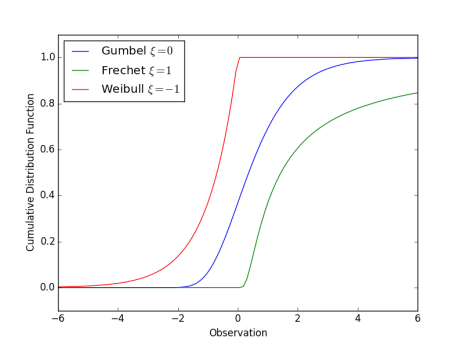Asymptotic distributions of the maximum
Starting from
 on can define the law of maximum
on can define the law of maximum
 as:
as:

If there exist a constants
 and a non-degenerate distribution
and a non-degenerate distribution
 such as:
such as:
Then
 is define as:
is define as:
![G_{\mu, \sigma, \xi}(x) = \left\{ \begin{array}{ll} exp\{ - [1 + \xi(\frac{x - \mu}{\sigma} )]_{+}^{1/\xi} \} \quad if \quad \xi \neq 0\\ exp\{ - exp[ (- \frac{x - \mu}{\sigma} )_{+}] \} \quad if \quad \xi = 0 \end{array} \right. Where \quad x_+= max(0,x)](../res/eq24.png)
Where
 are respectively the parameters of: location, scale and the shape of the model. Replacing in
are respectively the parameters of: location, scale and the shape of the model. Replacing in
 the variable
the variable
 by
by
 we obtain the standard shape of the distribution of the extreme values (GEV :Generalized Extreme Value):
we obtain the standard shape of the distribution of the extreme values (GEV :Generalized Extreme Value):
We say that
 is in the attraction domain of:
is in the attraction domain of:
Gumbel if

Fréchet if

Weibull if







